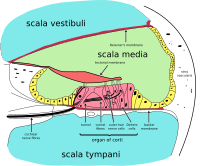
Photo from wikipedia
Abstract Background Hearing loss and deafness are well-known sequelae from bacterial meningitis (ABM) and may result in social dysfunction and learning difficulties. Yet, the timely development of hearing loss and… Click to show full abstract
Abstract Background Hearing loss and deafness are well-known sequelae from bacterial meningitis (ABM) and may result in social dysfunction and learning difficulties. Yet, the timely development of hearing loss and restitution is poorly studied, especially among adults. Hearing loss was revisited using otoacoustic emissions (OAEs) to determine the occurrence, magnitude, and development of hearing loss among adults with ABM. Methods Distortion product OAEs were measured in patients with ABM the day of admission and days 2, 3, 5–7, and 10–14 and at follow-up 30–60 days after discharge. Frequencies were categorized as low (1, 1.5, 2 kHz), mid (3, 4, 5 kHz), mid-high (6, 7, 8 kHz), and high (9, 10 kHz). Audiometry was performed on discharge and 60 days after. Results were compared with 158 healthy controls. Results OAE was obtained in 32 patients. ABM was due to S. pneumoniae in 12 patients (38%). All patients were treated with dexamethasone. OAE emission threshold levels (ETLs) were significantly decreased upon admission and at follow-up in all frequencies compared with healthy controls. A substantial and significant decrease in ETLs was found in S. pneumoniae meningitis. Sensorineural hearing loss (SNHL) >20 dB was present in 13 of 23 (57%) at discharge and in 11 of 18 patients (61%) 60 days after discharge. Hearing recovery decreased from day 3. Conclusions Hearing loss in ABM still affects >60% of patients despite treatment with dexamethasone. In S. pneumoniae meningitis, SNHL is profound and permanent. A window of opportunity for systemic or local treatments aiming to preserve cochlear function is proposed.
Journal Title: Open Forum Infectious Diseases
Year Published: 2023
Link to full text (if available)
Share on Social Media: Sign Up to like & get
recommendations!